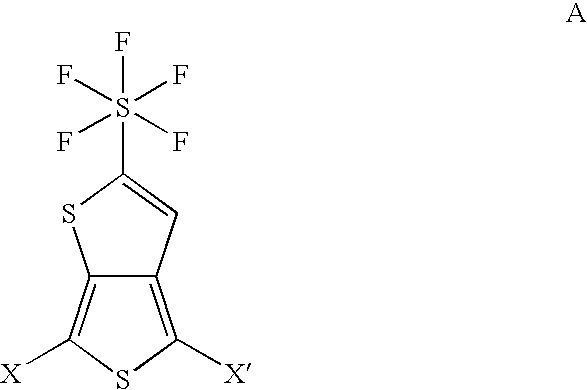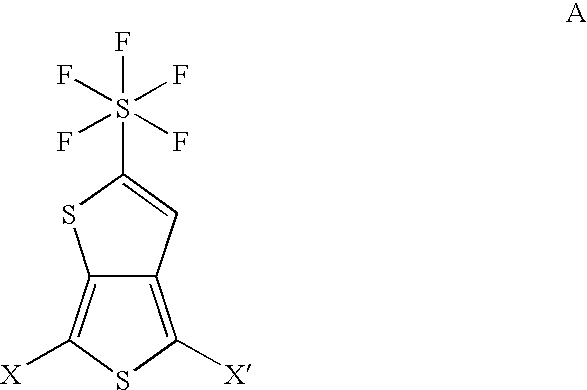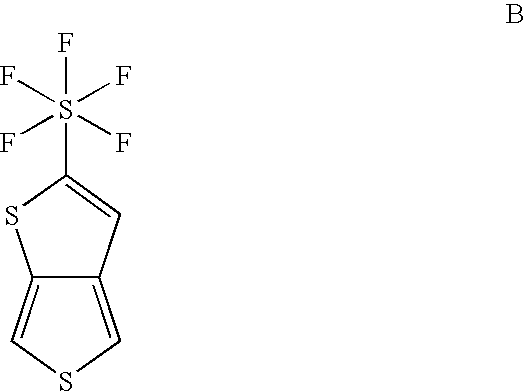Pentafluorosulfanyl-substituted thienothiophene monomers and conducting polymers
a technology of thienothiophene monomers and pentafluorosulfanyl, which is applied in the direction of organic active ingredients, hybrid capacitor electrodes, organic chemistry, etc., can solve the problems of limited solubility and photovoltaic properties of polymers containing dtt formed by electrochemical polymerization
- Summary
- Abstract
- Description
- Claims
- Application Information
AI Technical Summary
Benefits of technology
Problems solved by technology
Method used
Image
Examples
example 1
Production of 2-pentafluorosulfanyl-thieno[3,4-b]thiophene (2-SF5-TT)
[0050]The purpose of this example is to provide a representative five step route to produce the monomer 2-pentafluorosulfanyl-thieno[3,4-b]thiophene (2-SF5-TT) having the formula:
[0051]
[0052]Step 1 Formation of 3-bromo-4-(trimethylsilylethynyl)thiophene
[0053]
[0054]A 2-liter round-bottomed, three-necked flask was equipped with a reflux condenser, a mechanical stirrer, and a thermocouple, then purged with dry nitrogen gas. The flask was then charged with 240 g diethylamine (previously dried over KOH pellets and filtered), 387.04 g (1.60 mol.) 3,4-dibromothiophene, 800 mg (3.04 mmol) triphenylphosphine, 600 mg (5.48 mmol) copper(I)iodide, and 78.56 g (0.80 mmol.) trimethylsilylacetylene. The stirred mixture was warmed to 40° C. 2.00 g (2.8 mmol.) of dichlorobis(triphenylphosphine)palladium(II) was then added. The reaction was maintained at 40° C. for 4 hrs with mechanical stirring and a static nitrogen blanket. At tha...
example 2
Electrochemical Synthesis of Poly(2-pentafluorosulfanyl-thieno[3,4-b]thiophene)
[0070]2-Pentafluorosulfanyl-thieno[3,4-b]thiophene was dissolved in 100 mM tetrabutylammonium hexafluorophosphate / anhydrous acetonitrile solution to a concentration of 10 mM monomer and was electrochemically polymerized employing a 3-electrode configuration, using an ITO working electrode (1 cm2 Delta Technologies, Limited, Rs=5-15 Ohm, CG-50IN-CUV), platinum flag counter electrode (1 cm2), and a Ag / Ag+ nonaqueous reference electrode. The reference electrode (Bioanalytical Systems, Inc.; MF—2062) consisted of a Ag wire in a 0.1 M AgNO3 anhydrous acetonitrile solution. A CH Intruments Model 700B Series Electrochemical Analyzer / Workstation was utilized to drive the electrochemical polymerization at room temperature under a blanket of nitrogen. The applied potential was cycled between 1.6V and 0V at a rate of 100 mV / sec.
[0071]Polymerization was apparent from the development of a blue film on the surface of t...
example 3
Electrochemical Synthesis of Poly(2-pentafluorosulfanyl-thieno[3,4-b]thiophene)
[0072]2-Pentafluorosulfanyl-thieno[3,4-b]thiophene was dissolved in 100 mM tetrabutylammonium hexafluorophosphate / anhydrous acetonitrile solution to a concentration of 10 mM monomer and was electrochemically polymerized employing a 3-electrode configuration, using an ITO working electrode (1 cm2, Delta Technologies, Limited, Rs=5-15 Ohm; CG-50IN-CUV), platinum flag counter electrode (1 cm2), and a Ag / Ag+ nonaqueous reference electrode. The reference electrode (Bioanalytical Systems, Inc.; MF—2062) consisted of a Ag wire in a 0.1 M AgNO3 anhydrous acetonitrile solution. A CH Intruments Model 700B Series Electrochemical Analyzer / Workstation was utilized to drive the electrochemical polymerization at room temperature under a blanket of nitrogen. The applied potential was kept constant at 1.3V for 30 seconds.
[0073]Polymerization was apparent from the development of a blue film on the surface of the transparen...
PUM
| Property | Measurement | Unit |
|---|---|---|
| wt. % | aaaaa | aaaaa |
| wt. % | aaaaa | aaaaa |
| temperature | aaaaa | aaaaa |
Abstract
Description
Claims
Application Information
 Login to View More
Login to View More - R&D
- Intellectual Property
- Life Sciences
- Materials
- Tech Scout
- Unparalleled Data Quality
- Higher Quality Content
- 60% Fewer Hallucinations
Browse by: Latest US Patents, China's latest patents, Technical Efficacy Thesaurus, Application Domain, Technology Topic, Popular Technical Reports.
© 2025 PatSnap. All rights reserved.Legal|Privacy policy|Modern Slavery Act Transparency Statement|Sitemap|About US| Contact US: help@patsnap.com



